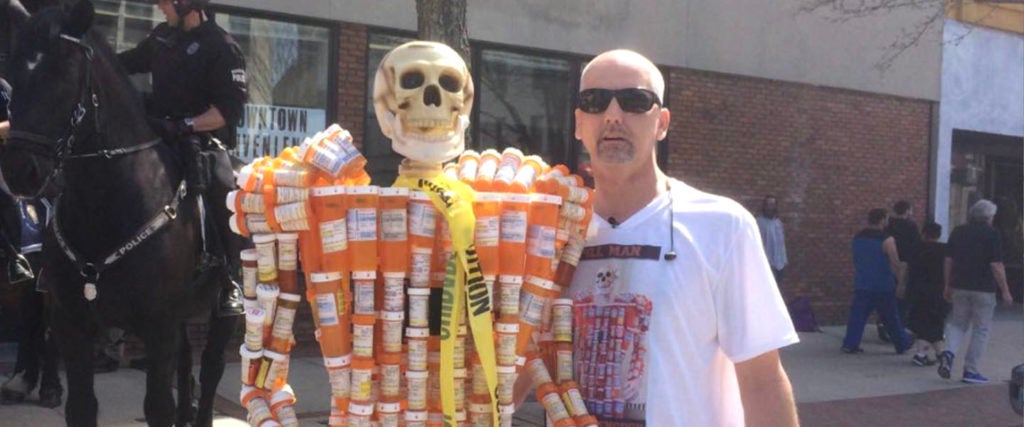Frank Huntley, 54, loiters outside a Walgreens in Worcester, Massachusetts, his hometown. Beside him stands a skeleton model made of well over 200 empty pill bottles for Percocet, OxyContin and methadone, opioids prescribed to Huntley after a neck and shoulder injury left him in chronic pain. A laminated sign at its feet reads, “Pill Man: One man’s fight to overcome opiate addiction.”
@frankrogar Be careful out there and if you’re about to start any medication please talk to your pharmacist #prescriptions Drugs #Tiktok
Two and a half decades earlier, the frame holding Huntley’s Pill Man together was decorated much differently — it looked like Frankenstein’s monster. He had a knack for building life-like figurines and threw Halloween parties for the neighborhood kids. He had two kids of his own, a wife and a business called Frank’s Painting and Wallpapering.
Then, on a random drive in 1998, Huntley’s arm popped out of its socket, an injury that resulted in two major surgeries and a prescription for Percocet. Not long after, his primary care physician called and said, “There’s a new drug out there called OxyContin.” As Huntley developed a tolerance to those, his doctor prescribed him methadone, too. By 2012, he was taking three Oxys every morning and 12 methadone pills a night.
All the while, Huntley got divorced and stopped working due to debilitating side effects from his daily handfuls of meds. “I wouldn’t shit for almost a week to two weeks when I took this medicine,” he tells me.
Huntley’s mind was suffering, too. He spent most days merely swallowing pills, smoking cigarettes and sipping on Mountain Dew. “Those are the only three things that I ever connected with for those 15 years,” he says.
But all that came to a halt in 2012, when Huntley’s doctor gave up his license and everyone else refused to prescribe him so many pills. They said he’d need to go to rehab. Huntley, however, couldn’t leave his son, who has cerebral palsy. “I had to take care of him,” he explains.
Instead, Huntley was prescribed a much lower dose of methadone (which went lower and lower) and had to quit everything else the hard way. “I went home, I suffered and it took me, oh my God, a year and a half to get my body back to normal,” he says. He spent that time experiencing heavy withdrawals, perpetually sweating, aching and feeling nauseous. But he had help from a therapist and Narcotics Anonymous.
In October 2013, Huntley took his last pill and hasn’t looked back since. “As I stopped taking these drugs, I started eating better, drinking better and getting my body back,” he says. He was only 125 pounds when he quit, but now he’s a healthy 185. He also quit cigarettes in 2014 and Mountain Dew in 2015. Although, despite his efforts, he adds that his body will “never be the same because of all those opiates.”
It was during his initial recovery when Huntley built Pill Man, who’s since accompanied him to the White House, Purdue Pharma headquarters, colleges and many, many street corners. “All I want to do is get out there and stand on the street corner to make sure the next guy isn’t gonna live like I did,” he tells me. “I don’t want them to lose the years I did.”
It wasn’t long before Huntley woke up one morning and felt as though Pill Man was sending him a message: “I need a roommate.” So, he made two more sculptures: Blackout, a liquor-bottle creation, and Addiction, which consists of all sorts of addictive goods — soda, fast food, cell phones, video games and so on. He also started a 501(c)(3) organization called Pill Man Inc. “When I wake up in the morning, I have my three sculptures looking at me,” Huntley says. “They’re my roommates.”
@frankrogar Please be careful of your addictions learn about these things before they control you #prescriptions Drugs #recovery #addiction #foryoupage
They’re his teammates, too, helping Huntley spread his message wherever he can on a daily basis. He believes they resonate because the opioid crisis — and addiction more generally — touches just about everyone’s life, directly or indirectly. “Firefighters, police officers, nurses and even judges stand in methadone lane every single morning to get a dose,” Huntley says. “You walk down the street and see a homeless person — you’re affected.”
Huntley emphasizes, however, that he’s not waging war against drugs. “I’m not trying to stop anyone from taking their medicine,” he explains. He just wants everyone to ask more questions about side effects and addictiveness before agreeing to new medications. “We all just need to start educating,” he says. “Hospitals need to start educating. Pharmacies need to start educating.”
In fact, Huntley doesn’t even blame his doctor for all the prescriptions he signed. “They want to make sure you’re not in pain,” he says. “A lot of these doctors don’t want to get you hooked on drugs.”
But people do get hooked, and more often than not, they had no idea that the pill prescribed to them for pain would bring them even more. That’s the conversation Huntley hopes his sculptures start. “I want Pill Man at every pharmacy,” he says. “He could help a lot of people.”
@frankrogar Please learn about the drugs on this planet you only have one body please take care of it #tiktok #fyp #keepfighting? #Superheroes

